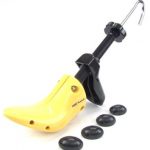Training Shoes Vs. Running Shoes – What is the difference?
This generation has seen many people much involved into sports and physical activities. The kind of apparel many people use in whatever activity they are into matters.
This leads to the debate – training shoes vs. running shoes.
Women, in particular, are over-obsessed when it comes to health issues and keeping fit is the way to go. Everyone has their own way of doing it. Whether you hit the trail for marathon runs, workout in the gym or take simple walks, a shoe is mandatory.
The problem these days is the ignorance to select the right footwear for the right activity. One major mistake that people do is pick whatever is handy and then they call it good.
What is the Difference – Training Shoes vs. Running Shoes?

Weight
Running shoes are ultra-lightweight. They are suitable for regular running.
The construction aims at reducing weight to power an athlete for forward movements. This helps to reduce fatigue and keep an athlete on track for prolonged periods.
Training shoes, on the contrast, are a little heavier. Engineered to bear weight, they are bulkier than running shoes. They have a high degree of cushioning which contributes to the added weight.
A cushier shoe is much comfortable on foot but the weight can limit its uses.
Functionality
Training shoes are perhaps the most versatile shoes. You can use them for various physical events except running. Your body goes through repeated movements during normal training sessions which condition the legs.
Activities like cardio dances and aerobics need proper shoes to perform different tricks. Such activities involve lateral movements of the legs and training shoes are just appropriate.
Training shoes feature additional support on the sides to enhance lateral feet movements. They also have wide soles which provide stability, especially for weightlifting. The broad width also provides extra support for activities involving lateral movements.
Running shoes on the other hand are for wearing whenever you want to run. They are the right footwear for joggers and runners.
Designed for forward movements, these shoes have extra cushioning to help in shock absorption. They feature treads on their soles that help propel runners forward. This design helps to channel energy from the runner’s legs to their feet as they run.

Training vs. Running Shoe Materials
Uppers
Training shoes are usually sturdy. Their uppers feature leather for durability and protection. Leather also stretches to conform to the uniqueness of the user’s feet. This material is also abrasion resistant thus prevents the shoe from tear.
Running shoe uppers are just everything runners need. They are lightweight, breathable and flexible. This makes them comfortable in all aspects.
Midsoles
Training shoe midsoles are stiffer and more stable. They feature a design that supports the foot for lateral movements as well as forward motion.
Running shoe midsoles often feature soft and foam materials. The cushioning is usually a single layer for lightweight. It also features added support substances to correct foot misalignment.
Soles
The soles of training shoes are stiffer and harder. They are non-marking as they are usually used indoors. The harder soles ensure durability considering that training shoes go through intense physical activities.
Running shoes often feature flexible, lugged and stickier rubber. Their flexibility allows the feet to lift and pound the ground with ease. The sticky rubber helps to grip the ground while running. It also prevents slips while running on wet surfaces.

Heel-to-toe drop
This refers to the relativity between the height of the heel to the height of the toe. It affects how your foot strikes the ground upon stepping. A low drop promotes a forefoot strike while a high drop promotes heel strike.
Training shoes have a mid offset, that is, between 4 to 8mm. The slight drop together with wide soles helps to distribute weight. This is beneficial to weightlifting addicts.
Running shoes have a low heel-to-toe drop – less than 4mm, sometimes up to zero. Shoes with low offset are usually used for longer distances. They have low risks of injuries as they put the body in proper alignment to the ground. They also distribute impact forces better.
Specific Applications
Training shoes are often considered as general athletic shoes. Their usage cuts across several physical activities.
You can wear them in the gym for stretching, yoga, lifting weights, and Zumba workouts. If you hit the tennis courts like twice a week, you can use them as well.
Running shoes are ideal for people who pound the track or trail. You can use them for morning runs, short hike runs and marathon competitions.
Summary of Pros and Cons
Training shoes
Pros
- Training shoes offer flexibility.
- The rubber sole allows you to perform a wide variety of movements and workouts. It also provides good floor traction necessary for stop-and-go activities.
- They are more comfortable as they feature a good cushioning system. You won’t feel tired after a vigorous session involving a lot of side-to-side movements.
- They are stable and supportive which is great for weightlifting.
- They support ankles well and prevent roll over.
- The broad sole creates a wide surface area that supports your body when squatting.
Cons
- Training shoes are heavy.
- The thick sole combined with thick layers of cushion increases their weight.
Running shoes
Pros
- They are super lightweight.
- They have improved athletic performance.
- Running shoes are quite breathable.
- They keep a runner’s feet cool even after miles of strenuous running.
- They have good heel support since you pound your heels on the ground as you run.
Cons
- They have less motion control features, thus, limiting the usage to running only.
- They might not be comfortable for heavy runners.
- Heavier runners need more cushioning and stability which running shoes lack.
Closing remarks
Now you realize the clear differences between training vs. running shoes. You should also realize the different purposes that each of them serves. So, always decide first on the activities you want to engage in before you buy either.
Training shoes do provide versatility, more stability and support. But, be aware that there isn’t one shoe fits all.
You can seek for advice from footwear specialists so that you are sure about your selections. They know a lot when it comes to training vs. running shoes.














